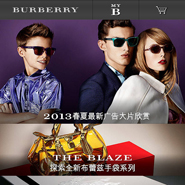- About
- Subscribe Now
- New York,
March 21, 2013

Burberry, Louis Vuitton and Chanel are the most tech-savvy fashion marketers in China, but the category as a whole must catch up with consumers’ digital demands, according to a new report from L2 Think Tank.
The first Fashion Supplement to the third annual Digital IQ Index: China found that seven of the 27 brands examined offer Chinese ecommerce, while third-party retailers such as Neiman Marcus and Net-A-Porter are ahead of the game with their tailored digital shopping platforms. Other key areas of improvement for luxury fashion marketers that are looking to reel in Chinese consumers include targeting Chinese tourists, site optimization and mobile marketing.
“Due to continued counterfeits, cannibalization and issues with logistics, most major luxury brands have been reluctant to invest in ecommerce,” said Emma Li, research lead at L2 Think Tank, New York.
“Over the past year, retail investment slowed down in China as brands took a more wait-and-see attitude due to the country’s slower economic growth and crackdown on public spending on luxury goods,” she said.
“Yet, in contrast, most third-party brands, among them Neiman Marcus and Net-A-Porter, are aggressively expanding into the market to fill the void.”
The Fashion Supplement to the Digital IQ Index: China ranks the digital competence of 27 global prestige fashion brands in the Chinese market on more than 800 data points.
Rankings are determined 20 percent on mobile, 30 percent on site, 30 percent on social media and 20 percent on mobile. Marketers are given rankings of Genius, Gifted, Average, Challenged or Feeble.
Europe in China
Though none of the 27 brands received a Genius ranking, Burberry came out as No. 1 in the report for its digital efforts in the Chinese market, followed by Louis Vuitton and Chanel. These brands are labeled as Gifted along with Coach.
Gucci and Armani are ranked at No. 5 and 6, respectively, and received an Average ranking.
Challenged brands are Christian Dior, Dolce & Gabbana and Hugo Boss.
Fashion brands ranked Feeble on their digital efforts in China include Alfred Dunhill, Valentino, Bottega Veneta, Bally, Balenciaga, Ermenegildo Zegna, Chloé, Givenchy, Salvatore Ferragamo, Diane von Furstenberg, Hermès, Fendi, Versace, Prada and Ralph Lauren.
Luxury fashion marketers upped their Chinese social media presence this year since, due to regulations in the market, they must look beyond Facebook and Twitter to reach socially-connected consumers.
Most brands studied, with the exception of four, have a presence on the most popular Chinese social media platform Sina Weibo.
Louis Vuitton on Weibo
Overall, 59 percent of the fashion brands studied maintain an account on at least two Chines social media sites.
For example, Burberry is present on four Chinese social media platforms after removing its page from Kaixin.
However, fashion marketers must look beyond social media this year to firmly establish their brand in the Chinese market and reap the benefits.
“The market will be even more important for luxury marketers over the next year,” Ms. Li said. “The race to reach younger, inland consumers will be waged online, so digital marketing in particular will be even more of a battleground for major brands.
“The winners will be the brands that can aggressively localize, be more innovative and move quickly to leverage changing consumer, technological and social media trends,” she said.
Always learning
Luxury fashion marketers must boost their Web presence in the Chinese market to match the overall brand experience.
This deficit in ecommerce also contributes to fashion marketers’ lack of targeting Chinese travelers.
Many of the brands studied have established Chinese-language Web sites, but less than half of them have tailored customer service.
Three of these brands’ Chinese-language sites feature live chat.
Also, Hugo Boss and Coach are the only marketers in the report to offer on-site Chinese language ratings and reviews.
“The most surprising learning in the study is that few brands are taking simple steps to cater to Chinese consumers traveling abroad, considering the importance of this group,” Ms. Li said.
“Although moving into the ecommerce space is difficult for brands, only Louis Vuitton offers a simple feature like offering prices in RMB [the official currency of China] on its Web site for outbound tourists to compare prices before traveling,” she said.
Louis Vuitton's Chinese-language site
Missing mobile
Mobile is another missed opportunity for luxury fashion marketers in China.
Android controls 90 percent of China’s smartphone market, per L2. However, none of the 27 brands studied have a Chinese-language Android application.
Additionally, Burberry is the only marketer studied that operates a mobile commerce site.
Burberry Chinese-language mobile site
“Just having a basic site is not enough,” Ms. Li said. “Brands need to create more reasons for fans to visit their sites.
“Optimizing for search engines is key to drive traffic to Web sites and social media is a new area for CRM,” she said. “Finally, mobile has become a must.”
Final Take
Tricia Carr, editorial assistant on Luxury Daily, New York
Share your thoughts. Click here